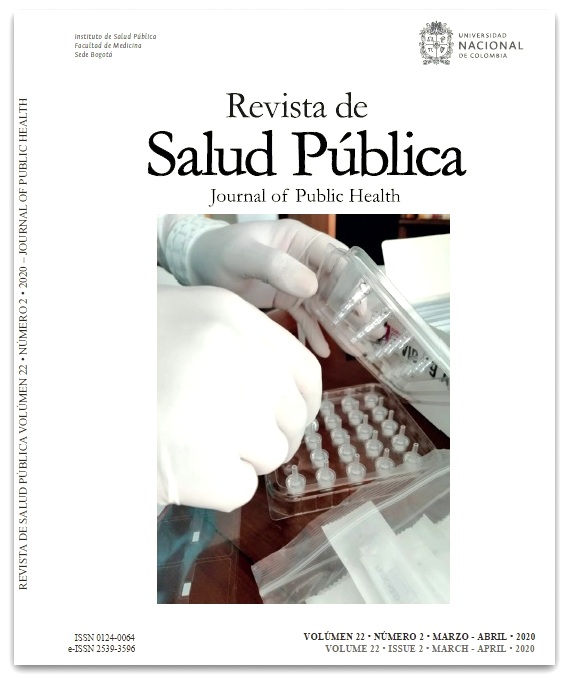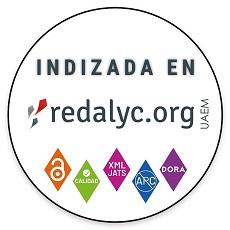Pandemia de la COVID-19 y las Políticas de Salud Pública en el Perú: marzo-mayo 2020
COVID-19 pandemic and Public Health Policies in Peru: March-May 2020
DOI:
https://doi.org/10.15446/rsap.v22n2.87373Palabras clave:
COVID-19, cuarentena, dinámicas no lineales, economía de la salud, pandemia (es)COVID-19, quarantine, nonlinear dynamics, health economics, pandemic (en)
Descargas
Objetivo El trabajo tiene como objetivo analizar la dinámica del comportamiento de la COVID-19 en el Perú, estimar y evaluar el impacto de la política pública de supresión (cuarentena).
Métodos El modelo epidemiológico SIR y la estimación con el método de Mínimos Cuadrados Ordinarios (MCO).
Resultados Se encontró que el número básico de propagación (Ro) cayó de 6,0 a 3,2 habiéndose reducido en 54% por efecto de la estrategia de supresión, y dos meses después cayó a 1,7. Sin embargo, sigue siendo alto y evidencia que aún continúa en expansión el nivel de infectados, con los efectos sociales y económicos adversos que esta medida implica.
Conclusión La COVID-19 es una enfermedad que crece exponencialmente, por lo cual, la política de salud basada en la estrategia de supresión ha permitido aplanar la curva de contagio, evitando el colapso del Sistema de Salud.
Objective The objective of the study is to analyze the behavior dynamics of COVID-19 in Peru, estimate and evaluate the impact of the suppression public policy (quarantine).
Methods The SIR epidemiological model and the estimation with the ordinary Least Squares (OLS) method.
Results It was found that the basic number of propagation (Ro) fell from 6,0 to 3,2 having been reduced by 54% due to the suppression strategy; and two months later it falls to 1,7. However, it remains high and evidence that the level of those infected continues to expand with its adverse social and economic effects.
Conclusion COVID-19 is a disease that grows exponentially, and that the health policy based on the suppression strategy has allowed to flatten the contagion curve, thus avoiding the collapse of the Health System.
Referencias
Lu R, Zhao X, Li J, Niu P, Yang B, Wu H, et al. Genomic characterization and epidemiology of 2019 novel coronavirus: implications for virus origins and receptor binding. The Lancet. 2020; 395(10224):565-74. DOI:10.1016/S0140-6736(20)30251-8.
Casella F. Can the COVID-19 epidemic be controlled on the basis of daily test reports? Physics and Society. 2020 [cited 2020 Apr 30]. Available from: https://bit.ly/2MAy8Bi.
Read JM, Bridgen JR, Cummings DA, Ho A, Jewell CP. Novel coronavirus 2019-nCoV: early estimation of epidemiological parameters and epidemic predictions. medRxiv. 2020: 1-11. DOI:10.1101/2020.01.23.20018549.
Kermack WO, McKendrick AG, Walker GT. A contribution to the mathematical theory of epidemics. Proceedings of the Royal Society of London. 1927; 115(772):700-21. DOI:10.1098/rspa.1927.0118.
Hethcote HW. The Mathematics of Infectious Diseases. SIAM Review. 2000 [cited 2020 Apr 30]; 42(4):599-653. Available from: https://bit.ly/3cBqql2.
Giordano G, Blanchini F, Bruno R, Colaneri P, Di Filippo A, Di Matteo A, et al. A SIDARTHE Model of COVID-19 Epidemic in Italy. 2020 [cited 2020 Apr 30]. DOI:10.1038/s41591-020-0883-7.
Flaxman S, Mishra S, Gandy A, Unwin H, Coupland H, Mellan T, et al. Report 13: Estimating the number of infections and the impact of non-pharmaceutical interventions on COVID-19 in 11 European countries 2020 [cited 2020 Apr 30]. Available from: https://bit.ly/2MAHTzx.
Birbuet JC, Lopez R. Dinámica de expansión del COVID-19 en Bolivia durante las primeras 6 semanas. Documento de trabajo. 2020 [cited 2020 Apr 30]. Available from: http://bit.ly/pdf_covid_bol.
Cómo citar
APA
ACM
ACS
ABNT
Chicago
Harvard
IEEE
MLA
Turabian
Vancouver
Descargar cita
CrossRef Cited-by
1. Eleuterio Quispe Poma, Elbio Labra Chino, Fredy Abel Huanca Torres, Abel Angel Sullon Macalupu. (2023). Software Engineering Application in Systems Design. Lecture Notes in Networks and Systems. 596, p.442. https://doi.org/10.1007/978-3-031-21435-6_38.
2. Chaoqian Wang, Chaochao Huang. (2020). An epidemic model with the closed management in Chinese universities for COVID-19 prevention. Journal of Physics: Conference Series, 1707(1), p.012027. https://doi.org/10.1088/1742-6596/1707/1/012027.
3. Josefina Amanda Suyo-Vega, Monica Elisa Meneses-La-Riva, Víctor Hugo Fernández-Bedoya, Maricela Alarcón-Martínez, Hitler Giovanni Ocupa-Cabrera, Sofía Almendra Alvarado-Suyo, Ana da Costa Polonia, Angélica Inês Miotto. (2022). Educational policies in response to the pandemic caused by the COVID-19 virus in Latin America: An integrative documentary review. Frontiers in Education, 7 https://doi.org/10.3389/feduc.2022.918220.
4. Carmen Luisa Linares Torres, Gema Natividad Sologuren García , Gloria Regina Escobar Bermejo , María Soledad Soto Valdivia , Ofelia María de Jesús Alencastre Mamani , Lyzzeth Beatriz Alvarado Ocrospoma , Luis Fredy Choque Mamani . (2024). Perfil sociodemográfico y obstétrico de usuarias de métodos anticonceptivos en pandemia. https://doi.org/10.59899/per-soci.
5. Víctor Raúl Ocaña Gutiérrez, Rodolfo Arturo González Ramírez, Víctor Alexander Ocaña Aguilar, Nadia Gabriela Ocaña Aguilar, Carlos Enrique Holguín Mauricci, Jie Zhang. (2024). The weekly P25 of the age of the influenza-like illness shows a higher correlation with COVID-19 mortality than rapid tests and could predict the evolution of COVID-19 pandemics in sentinel surveillance, Piura, Perú, 2021. PLOS ONE, 19(3), p.e0295309. https://doi.org/10.1371/journal.pone.0295309.
6. Luis Varona, Jorge R Gonzales, Benjamín García, Laura Gismera. (2024). Economic growth and the foreign sector: Peru 1821–2020. Cambridge Journal of Economics, 48(6), p.1051. https://doi.org/10.1093/cje/beae019.
7. David Villarreal-Zegarra, Rubi Paredes-Angeles, Nikol Mayo-Puchoc, Enoc Arenas-Minaya, Jeff Huarcaya-Victoria, Anthony Copez-Lonzoy. (2024). Psychometric properties of the GAD-7 (General Anxiety Disorder-7): a cross-sectional study of the Peruvian general population. BMC Psychology, 12(1) https://doi.org/10.1186/s40359-024-01688-8.
8. Lilian Sofía Ramírez Berrío, Esteban Orlando Vanegas Duarte, Alejandra Velásquez Morales, Gloria Isabel Niño Cruz, Leonardo Salas Zapata, Andrea Ramírez Varela. (2024). COVID-19 Pandemic Preparedness and Response in Latin American Countries: Scoping Review and Analysis Based on World Health Organization Standards. Disaster Medicine and Public Health Preparedness, 18 https://doi.org/10.1017/dmp.2024.142.
9. Henry Santa-Cruz-Espinoza, Gina Chávez-Ventura, Julio Dominguez-Vergara, César Merino-Soto. (2024). Occupational self-efficacy scale: Validity in teachers. Acta Psychologica, 249, p.104441. https://doi.org/10.1016/j.actpsy.2024.104441.
10. Nikol Mayo-Puchoc, Jenny Bejarano-Carranza, Rubí Paredes-Angeles, Ana Lucía Vilela-Estrada, Jackeline García-Serna, Noelia Cusihuaman-Lope, David Villarreal-Zegarra, Victoria Cavero, Sara Ardila-Gómez. (2023). Paper promises: Peruvian frontline health workers’ perspectives on mental health policies during COVID-19. Health Policy and Planning, 38(Supplement_2), p.ii3. https://doi.org/10.1093/heapol/czad055.
11. Luis Varona-Castillo, Jorge Ricardo Gonzales-Castillo. (2021). Crecimiento económico y distribución del ingreso en Perú. Problemas del Desarrollo. Revista Latinoamericana de Economía, 52(205) https://doi.org/10.22201/iiec.20078951e.2021.205.69636.
12. Emilio Rosario Pacahuala, Aldo Medina Gamero. (2022). Nuevas oportunidades para estudiantes de las facultades de salud en el contexto de la COVID-19. Atención Primaria, 54(2), p.102179. https://doi.org/10.1016/j.aprim.2021.102179.
13. Abel Marcial Oruna Rodríguez, Evelin Brigitte Valencia Giraldo, Miguel Ángel Oruna Rodríguez, Jaime Agustín Sánchez Ortega. (2021). Documento Identidad Nacional Electrónico: Seguridad asociada y mecanismo de ampliación tributaria. Revista Venezolana de Gerencia, 26(6 Edición Especial), p.539. https://doi.org/10.52080/rvgluz.26.e6.33.
14. Aldo Medina Gamero, Emilio Rosario Pacahuala. (2021). Retos en el estudiante de posgrado de medicina durante la COVID-19. Atención Primaria Práctica, 3(4), p.100099. https://doi.org/10.1016/j.appr.2021.100099.
15. Andrea Riccardo Migone. (2020). The influence of national policy characteristics on COVID-19 containment policies: a comparative analysis. Policy Design and Practice, 3(3), p.259. https://doi.org/10.1080/25741292.2020.1804660.
Dimensions
PlumX
- Citations
- CrossRef - Citation Indexes: 11
- Policy Citation - Policy Citations: 1
- PubMed - Citation Indexes: 6
- Scopus - Citation Indexes: 22
- Usage
- SciELO - Full Text Views: 1192
- SciELO - Full Text Views: 1122
- SciELO - Abstract Views: 358
- SciELO - Abstract Views: 357
- SciELO - Full Text Views: 7
- SciELO - Abstract Views: 3
- Captures
- Mendeley - Readers: 158
- Mendeley - Readers: 145
- Mendeley - Readers: 20
Visitas a la página del resumen del artículo
Descargas
Licencia
Derechos de autor 2020 Revista de Salud Pública

Esta obra está bajo una licencia internacional Creative Commons Atribución 4.0.
Esta revista provee acceso libre inmediato a su contenido bajo el principio de que hacer disponible gratuitamente investigación al publico apoya a un mayor intercambio de conocimiento global.
Todos los contenidos de esta revista, excepto dónde está identificado, están publicados bajo una Licencia Creative Commons Atribución 4.0.




 LICENCIADO / TÍTULOECONOMISTAUNIVERSIDAD NACIONAL DE PIURAPERÚ
LICENCIADO / TÍTULOECONOMISTAUNIVERSIDAD NACIONAL DE PIURAPERÚ DOCTORADODOCTOR EN CIENCIAS DE LA SALUDUNIVERSIDAD NACIONAL DE PIURAPERÚ
DOCTORADODOCTOR EN CIENCIAS DE LA SALUDUNIVERSIDAD NACIONAL DE PIURAPERÚ
















